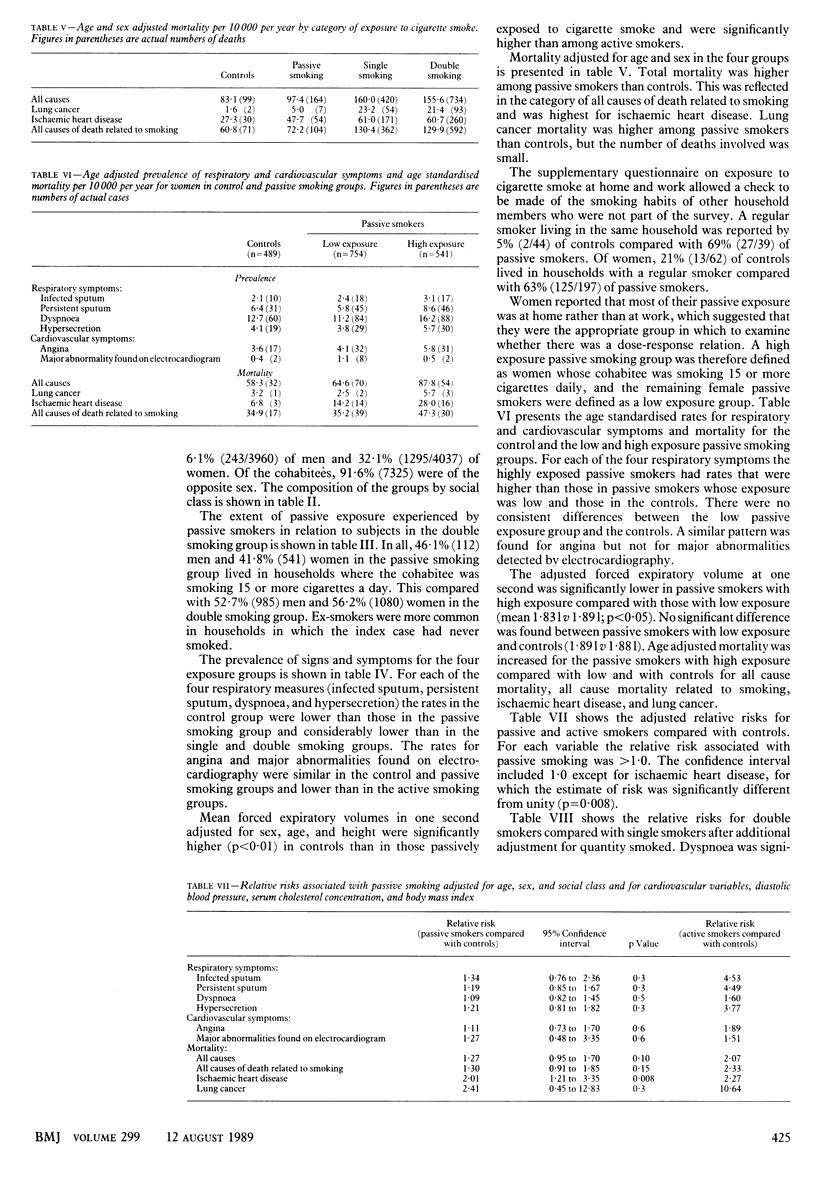Abstract
OBJECTIVE-To assess the risk of cardiorespiratory symptoms and mortality in non-smokers who were passively exposed to environmental smoke. DESIGN--Prospective study of cohort from general population first screened between 1972 and 1976 and followed up for an average of 11.5 years, with linkage of data from participants in the same household. SETTING--Renfrew and Paisely, adjacent burghs in urban west Scotland. SUBJECTS--15,399 Men and women (80% of all those aged 45-64 resident in Renfrew or Paisley) comprised the original cohort; 7997 attended for multiphasic screening with a cohabitee. Passive smoking and control groups were defined on the basis of a lifelong non-smoking index case and whether the cohabitee had ever smoked or never smoked. MAIN OUTCOME MEASURE--Cardiorespiratory signs and symptoms and mortality. RESULTS--Each of the cardiorespiratory symptoms examined produced relative risks greater than 1.0 (though none were significant) for passive smokers compared with controls. Adjusted forced expiratory volume in one second was significantly lower in passive smokers than controls. All cause mortality was higher in passive smokers than controls (rate ratio 1.27 (95% confidence interval 0.95 to 1.70)), as were all causes of death related to smoking (rate ratio 1.30 (0.91 to 1.85] and mortality from lung cancer (rate ratio 2.41 (0.45 to 12.83)) and ischaemic heart disease (rate ratio 2.01 (1.21 to 3.35)). When passive smokers were divided into high and low exposure groups on the basis of the amount smoked by their cohabitees those highly exposed had higher rates of symptoms and death. CONCLUSION--Exposure to environmental tobacco smoke cannot be regarded as a safe involuntary habit.
Full text
PDF




Selected References
These references are in PubMed. This may not be the complete list of references from this article.
- Colley J. R., Holland W. W., Corkhill R. T. Influence of passive smoking and parental phlegm on pneumonia and bronchitis in early childhood. Lancet. 1974 Nov 2;2(7888):1031–1034. doi: 10.1016/s0140-6736(74)92148-5. [DOI] [PubMed] [Google Scholar]
- Garland C., Barrett-Connor E., Suarez L., Criqui M. H., Wingard D. L. Effects of passive smoking on ischemic heart disease mortality of nonsmokers. A prospective study. Am J Epidemiol. 1985 May;121(5):645–650. doi: 10.1093/aje/121.5.645. [DOI] [PubMed] [Google Scholar]
- Gillis C. R., Hole D. J., Hawthorne V. M., Boyle P. The effect of environmental tobacco smoke in two urban communities in the west of Scotland. Eur J Respir Dis Suppl. 1984;133:121–126. [PubMed] [Google Scholar]
- Gillis C. R., Hole D. J., Hawthorne V. M. Cigarette smoking and male lung cancer in an area of very high incidence. II. Report of a general population cohort study in the West of Scotland. J Epidemiol Community Health. 1988 Mar;42(1):44–48. doi: 10.1136/jech.42.1.44. [DOI] [PMC free article] [PubMed] [Google Scholar]
- Hawthorne V. M., Gillis C. R., Maclean D. S. Monitoring health in Scotland. Int J Epidemiol. 1972 Winter;1(4):369–374. doi: 10.1093/ije/1.4.369. [DOI] [PubMed] [Google Scholar]
- Hawthorne V. M., Greaves D. A., Beevers D. G. Blood pressure in a Scottish town. Br Med J. 1974 Sep 7;3(5931):600–603. doi: 10.1136/bmj.3.5931.600. [DOI] [PMC free article] [PubMed] [Google Scholar]
- Hirayama T. Passive smoking--a new target of epidemiology. Tokai J Exp Clin Med. 1985 Aug;10(4):287–293. [PubMed] [Google Scholar]
- Kauffmann F., Tessier J. F., Oriol P. Adult passive smoking in the home environment: a risk factor for chronic airflow limitation. Am J Epidemiol. 1983 Mar;117(3):269–280. doi: 10.1093/oxfordjournals.aje.a113539. [DOI] [PubMed] [Google Scholar]
- Lee P. N. Misclassification as a factor in passive smoking risk. Lancet. 1986 Oct 11;2(8511):867–867. doi: 10.1016/s0140-6736(86)92906-5. [DOI] [PubMed] [Google Scholar]
- Matsukura S., Taminato T., Kitano N., Seino Y., Hamada H., Uchihashi M., Nakajima H., Hirata Y. Effects of environmental tobacco smoke on urinary cotinine excretion in nonsmokers. Evidence for passive smoking. N Engl J Med. 1984 Sep 27;311(13):828–832. doi: 10.1056/NEJM198409273111305. [DOI] [PubMed] [Google Scholar]
- Svendsen K. H., Kuller L. H., Martin M. J., Ockene J. K. Effects of passive smoking in the Multiple Risk Factor Intervention Trial. Am J Epidemiol. 1987 Nov;126(5):783–795. doi: 10.1093/oxfordjournals.aje.a114715. [DOI] [PubMed] [Google Scholar]
- Wald N. J., Boreham J., Bailey A., Ritchie C., Haddow J. E., Knight G. Urinary cotinine as marker of breathing other people's tobacco smoke. Lancet. 1984 Jan 28;1(8370):230–231. doi: 10.1016/s0140-6736(84)92156-1. [DOI] [PubMed] [Google Scholar]
- Wald N. J., Nanchahal K., Thompson S. G., Cuckle H. S. Does breathing other people's tobacco smoke cause lung cancer? Br Med J (Clin Res Ed) 1986 Nov 8;293(6556):1217–1222. doi: 10.1136/bmj.293.6556.1217. [DOI] [PMC free article] [PubMed] [Google Scholar]
- Wald N., Ritchie C. Validation of studies on lung cancer in non-smokers married to smokers. Lancet. 1984 May 12;1(8385):1067–1067. doi: 10.1016/s0140-6736(84)91467-3. [DOI] [PubMed] [Google Scholar]
- White J. R., Froeb H. F. Small-airways dysfunction in nonsmokers chronically exposed to tobacco smoke. N Engl J Med. 1980 Mar 27;302(13):720–723. doi: 10.1056/NEJM198003273021304. [DOI] [PubMed] [Google Scholar]


